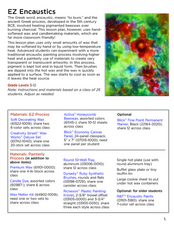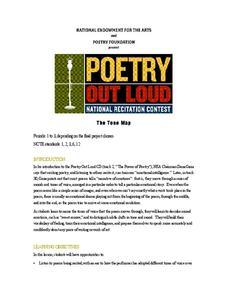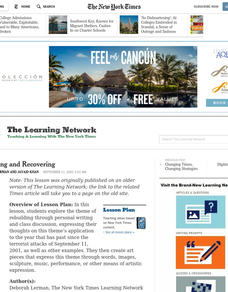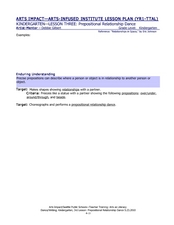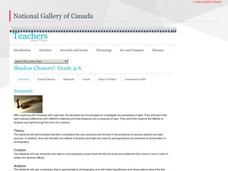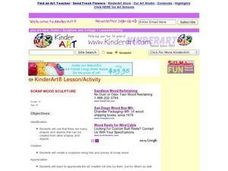Curated OER
EZ Encaustics
Have your class design a piece of art work using a canvas panel and wax. Learners employ a Greek process of art design popular in the fifth century to create their works. This is a great way to incorporate history into an art lesson.
Curated OER
Modern Mosaics
Students examine how native peoples used ceramic pieces to create art. Individually, they create a design of their choice using erasable markers and trace over it with a pencil. To end the lesson plan, they use shapes and colors to...
Curated OER
Doodle Splash
Students navigate Doodle Splash to create a painting. In this doodle splash lesson, students explain their splash painting relationship to a piece of literature.
Curated OER
Making Shapes
Here is a nice way to explore shapes with your little ones. Get well cards are made by painting one half of a piece of paper, folding it in half, and having the design copy itself in a mirror image on the other half of the paper. They...
Curated OER
Collaborate
A really good way for kids to learn how to work together is to create something together. Here, learners work together to complete a puzzle as a warm up. Then, they decide on a theme for a "Mutual Mural." After talking about how to...
Curated OER
Comparing Two Improvisations
Jazz improvisation can be difficult to listen to for some music enthusiasts, however there are patterns and characteristics that can be analyzed. They use this Venn diagram to aid them in comparing two improvisational pieces, where they...
Curated OER
Tree Bark
Young scholars explore and display textures of tree bark in a patterned arrangement of positive and negative space. They make crayon rubbings with various colors and arrange them in an original repetitive pattern. They glue finished...
Curated OER
Know Noses
Students use the internet to find out all they can about noses. As a class, they develop characteristics for a super nose. Individually, they take an existing human or animal nose and sketch a new design. To end the lesson, they mount it...
Curated OER
Blank Story Board
While this resource doesn't look like much at first glance, it has the potential to become anything your class can dream up. It is a blank story board template which you can print and use for a wide variety of lessons. Tip: Have learners...
Curated OER
Harmony with Drones
A drone is the simplest of all harmonies, you'll play or sing an example and your class will follow along. They listen to, and then play or sing drones. Two pieces containing drones are included for you to print, pass out, and play.
Curated OER
Danse Macabre: Saint-Saëns
Assist your youngsters as they learn to visualize the story music can tell us. They listen to the piece "Danse Macabre" while viewing this slideshow. Each slide describes the key instrument and what creature of the dark it represents. A...
Curated OER
Peter and the Wolf: The Character of Instruments
Is your class familiar with the tale of Peter and the Wolf? If they are, they will have fun testing themselves on how well they can identify each character by listening to the piece. This presentation acts as a quiz where the class works...
Curated OER
The Tone Map
Poems are meant to be heard. Hearing a poem being read enriches one’s understanding of the tone and mood of the piece. Introduce your class to the sounds of poetry with a packet that not only details how to use poetry recordings in the...
Poetry Out Loud
Poems Put to Use
Why do we have to study poetry? Here is a lesson that demonstrates some of poetry's more practical and real-world applications for reluctant learners. Start by leading a brainstorming session about where poems or pieces of poems might be...
Hawaiʻi State Department of Education
Dance Critic
What do writing and dance have in common? They both have a six-trait rubric for assessment. Just like a good story, a good dance must have a hook, beginning, middle, end, logical sequence, and a climax. Learners use a...
Hawaiʻi State Department of Education
Story Design
Stories contain very specific elements; plot, characters, and key events. Learners use pantomime to retell a key event from the beginning, middle, and end of a story. They discuss setting and character as each group discusses and then...
Curated OER
Rebuilding and Recovering
What does it mean to rebuild and recover after a major event? Your class will explore this theme while they discuss and discover the events surrounding September 11. They will also look at other examples and then create art pieces that...
Hawaiʻi State Department of Education
Finding the Main Idea
You can mix almost any subject with an arts curriculum. Find out how to use drama to find the main idea of a literary text. You'll read a story, and then learners will make tableaus showing what happened, or what they think will happen...
Curated OER
Prepositional Relationship Dance
Students learn the meaning of prepositions through movement. For this dance lesson, students choreograph a piece showing that they understand the meaning of various prepositions.
National Gallery of Canada
Shadow Chasers!
Experiment with light and shadow with a photography lesson. Learners first view several artistic photographs. They then play with different levels of light and various objects, eventually putting together compositions and taking pictures...
Margaret Bearden
Painted Interiors by Andrew Wyeth
Although this 13-slide presentation focuses on lesser-known works by Andrew Wyeth viewers will still recognize his color pallette, realism, and stark images.
Evergreen Exhibitions
Leonardo da Vinci: Machines in Motion
Motion is the focus of ten hands-on activities that challenge scholars to build machines invented by Leonardo da Vinci. Following several steps, small groups work collaboratively to recreate machines including levers, pulleys, wheels,...
Curated OER
SCRAP WOOD SCULPTURE
Students see that there are many shapes and objects that can be created from other shapes and objects, and create a sculpture using bits and pieces of scrap wood. Includes instructions on how to make Tempera wood stain
Curated OER
Weaving a Watercolor
Students examine the color wheel and work with watercolors. In this color lesson, students go over primary, secondary, and intermediate colors before watching a demonstration of watercolor brush techniques. They choose a shape to paint...


